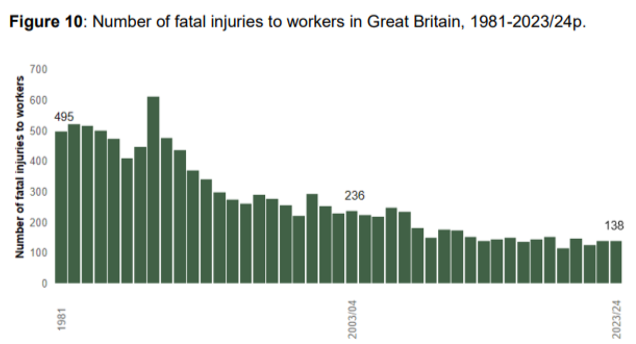“Back in my day, we didn’t have any of this health and safety nonsense.” Most people have heard colleagues, friends, or family express similar sentiments in regards to health and safety laws they may personally find restrictive. In 1974, the implementation of the Health and Safety at Work Act marked a significant milestone as the first major labour law to govern all workplaces. It also notably increased accountability for both employers and employees. However, in the last 50 years, how has the Health & Safety At Work Act affected workplaces in the UK? Let’s take a look at the facts.
The British Safety Council summarises key factors that the HASAWA requires workplaces to provide:
- Adequate training of staff to ensure health and safety procedures are understood and adhered to
- Adequate welfare provisions for staff at work
- A safe working environment that is properly maintained and where operations within it are conducted safely
- Suitable provision of relevant information, instruction and supervision
Over the past 50 years, fatal injuries in the workplace to workers (per 100,000 worker) have mostly been on a downward trend, with the years leading up to the pandemic being broadly flat. By examining statistics just from the construction industry, we see that the highest number of work-related fatal injuries to employees in a year was in 1975 with 182 deaths recorded. The lowest was 2018/2019, with 18 deaths recorded.
A similar trend can be seen with work-related ill-health. However, in reports from 2022/23, around half of all self-reported work-related ill health was attributed to stress and anxiety, which is higher than what was seen pre-pandemic. Current statistics show that this figure has risen by 2.6% from the level it was at in 2018/19. It is without a doubt that the rise in this statistic can be partly due to the raised awareness of stress and anxiety in recent years, which we believe to be a good thing as without awareness it is impossible to tackle a problem. However, have the stresses of modern life increased since the pandemic, also contributing to this rise in reporting?
The Dräger Safety and Health at Work Report shows that the cost of living crisis is having an effect on workers particularly in younger generations, with 59% of Gen Z (those born between 1997 – 2012) reporting that they are currently experiencing anxiety or depression, compared with only 29% of Gen X (1965 – 1980), reducing further throughout the generations with just 18% of Baby Boomers (1946 – 1964).
Based on these statistics, and combined with the fact that younger generations are entering the workforce, the rise in self-reported work-related ill-health attributed to stress and anxiety is not surprising.
Currently, the HASAWA does not say much about mental health besides placing a ‘duty of care’ on employers to protect their employees from the risk of stress at work. This then begs the question, with cases of stress and anxiety becoming more and more commonplace, will the HASAWA be revised to include more on mental health?
The Dräger report states that 94% of people feel that, in light of changing workplaces and different working styles, UK Health and Safety legislation should be overhauled. 82% of respondents also reported that they believed a greater focus on mental health/ wellbeing is a factor most likely to be seen as important in driving businesses and Government to rethink their approach to Health & Safety.
However, it is positive to note that that workers generally feel safer at work than in the past, due to better safety training, more focus on mental health and wellbeing, and employers investing in workplace safety.

